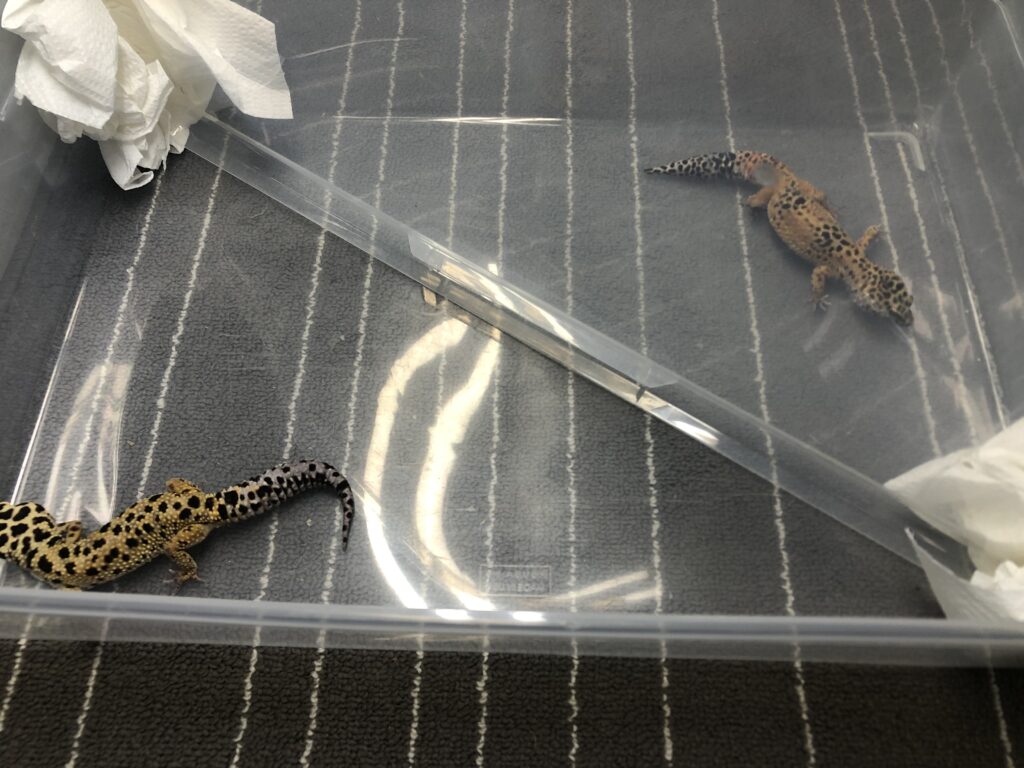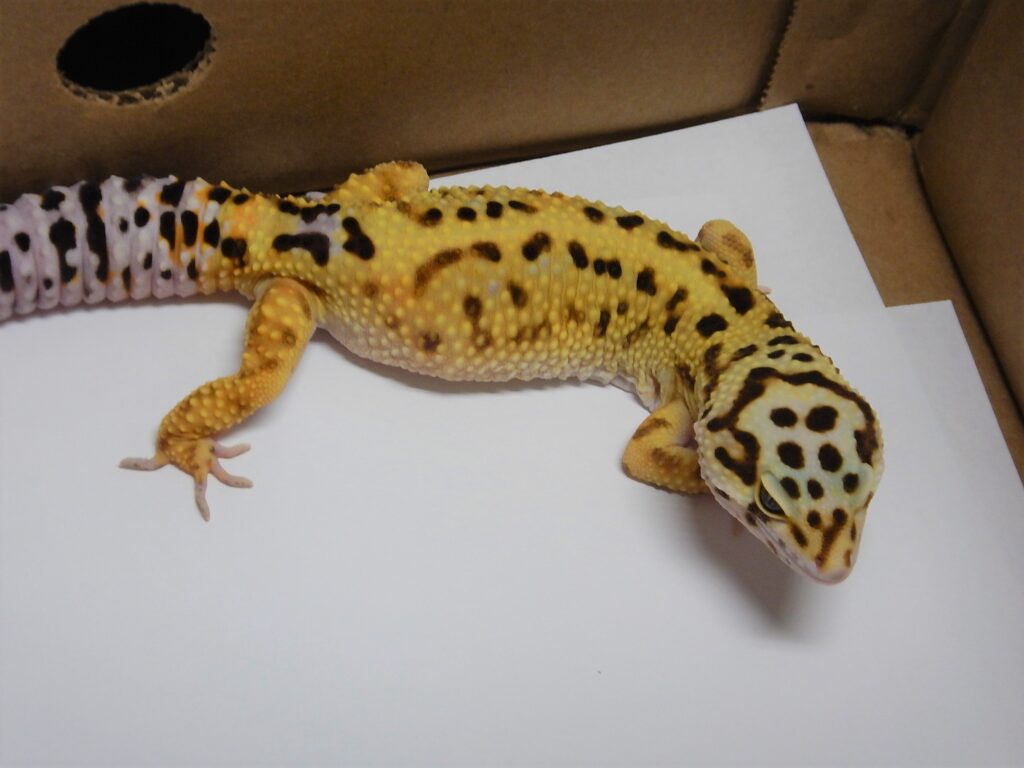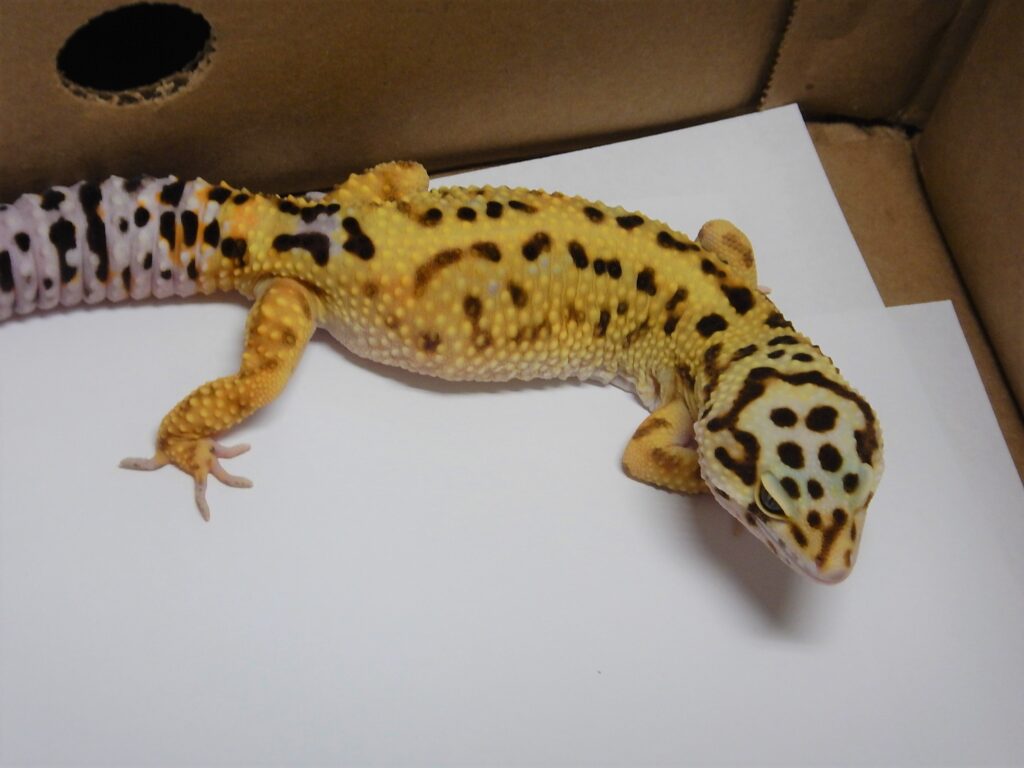Breeding Eublepharis macularius for six years, I have witnessed the tail vibration in males of the species every breeding season when introducing females into male enclosures. I have gathered that the vibration is caused by a female’s presence.
Ron Tremper, one of the original keepers and foremost authorities of E. macularius in captivity, concluded that once “you introduce an adult female to the cage (of a male) for breeding purposes, the first thing you may hear and/or witness is the male going through his tail vibration routine.”‘1 But in this description, he is not specific; Does the male vibrate his tail after he sees the female? After he tongue flicks? Is this the only time a male will vibrate his tail? It is unclear. In 1997, Cooper and Steele determined that the presence of female pheromones could cause tail vibration responses in males, meaning that the view of a female is not required to cause a male tail vibration.’2 But could a view of a female trigger a tail vibration in a male? The goal for this experiment was to determine if sight could cause tail vibrations or if female pheromones were required.
For this experiment, a 32 quart plastic tub was used. Its transparent plastic lid was perpendicularly placed inside of the tub at an angle so that it touched the two opposite corners, which split the 32 quart plastic tub into two triangles. The two corners touched by the lid were stuffed with paper towels to create further stability. This was done so that the geckos could see each other’s, but they could not come into contact and potentially pick up eachother’s pheromones.
One of the triangular areas was marked as Triangle #1, and the other as Triangle #2. Three male E. macularius were tested in an attempt to achieve the goal of the experiment. One of the three males was placed in Triangle #1. Then, a female was placed in Triangle #2. Once the male indicated that he acknowledged that there was another gecko through the plastic by tongue flicking and pointing his head towards her, the male was given five minutes to vibrate his tail. Whether or not the male’s (in Triangle #1) tail vibrated was recorded. Then, a male E. macularius that was not one of the other three participants was placed in Triangle #2, and the male in Triangle #1 was given five minutes to vibrate his tail once he acknowledged the gecko in Triangle #2. Whether or not the male’s (in Triangle #1) tail vibrated was recorded. Finally, a female was placed in Triangle #2. A q-tip was rubbed on the female’s femoral pores gently for three seconds. Then, the q-tip was presented to the male in Triangle #1. Once the male in Triangle #1 acknowledged the female through the plastic and tongue-flicked ath the q-tip, he was given thirty seconds to vibrate his tail. Whether or not the male’s (in Triangle #1) tail vibrated was recorded. Then, a different q-tip was rubbed on a male’s femoral pores (the same male that entered Triangle #2 second) gently for three seconds. Then, the q-tip was presented to the male in Triangle #1. The female in Triangle #2 remained. Once the male in Triangle #1 acknowledged the female and tongue-flicked at the q-tip, he was given thirty seconds to vibrate his tail. Whether or not the male’s (in Triangle #1) tail vibrated was recorded. This concluded the experiment for the male in Triangle #1. This procedure was done two more times for two different males in Triangle #1, with the exact same individuals used in Triangle #2 as the first experiment. The male in Triangle #1 was placed in his enclosure, and the container and lid were washed with dish soap and dried and the paper towels were replaced to set up the experiment for the next male. Each q-tip was only used to rub one gecko’s femoral pores, and then it was discarded. If a gecko escaped the container, the timer was paused. The gecko was then returned and the timer was resumed.


Results:
| Tail vibration from sight of female | Tail vibration from sight of male | |
| Male #1 | no | no |
| Male #2 | no | no |
| Male #3 | no | no |
| Tail vibration from pheromones of female and sight of female | Tail vibration from pheromones of male and sight of female | |
| Male #1 | yes | no |
| Male #2 | no | no |
| Male #3 | yes | no |

It should be stated that a greater number of male E. macularius should be tested using this experiment for more accurate and significant results. Ideally, 20 males would have been used. This could not be achieved due to resources. But from these results, it can be seen that male E. macularius will vibrate their tails only in response to the sight and pheromones of a female (potentially just pheromones but that was not examined in this experiment). The sight of another of the same species as well as the pheromones of a E. macularius male do not trigger tail vibrations.
References:
- “Leopard Geckos: The Next Generations” (Page 50) Ron Tremper, 2020. Retrieved June 23rd, 2021.
- “Pheromonal Discrimination of Sex by Male and Female Leopard Geckos (Eublepharis macularius)” Journal of Chemical Ecology, William E. Cooper and Laura Steele, 1997. Retrieved July 15th, 2021.